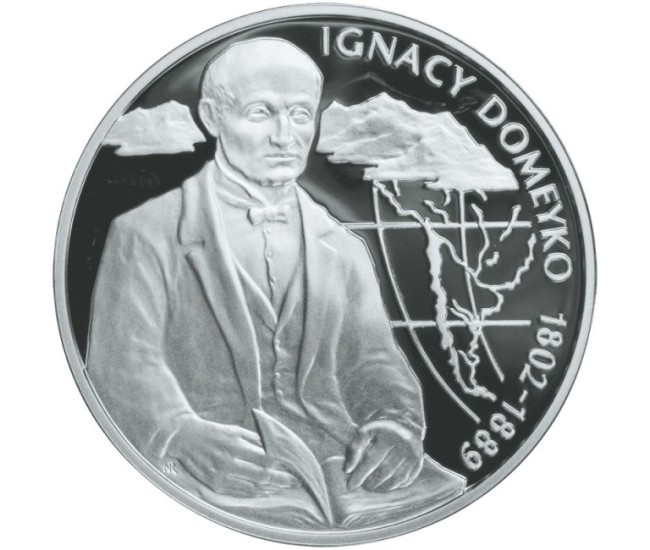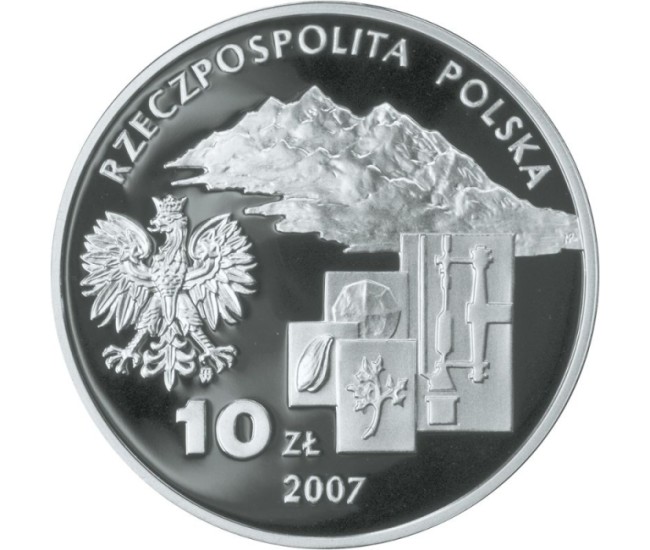collector coin
Europe / Poland / since 1995
10 zł Ignacy Domeyko
Poland 2007 14,14 g Ag 925
Catalogue number
LR #2493
Denomination
10 zł
Country
Poland
Age
since 1995
Metal
Ag
Fineness (purity)
925
Weight
14,14 g
Diameter
32 mm
Quality
Proof
Year of issue
2007
Certificate
No
Box
No
Mintage
55 000 pcs.
25 $
Catalog price
0.0
0 vote
0 people have this on favourite
0 people have this on their collection
 Oceń: wygląd, temat, nakład
Oceń: wygląd, temat, nakład
The coin's reverse shows an image of sitting Ignacy Domeyka with an open book, as well as the geographical grid and contours of the South American continent. On the obverse there are images of a fragment of a technical drawing depicting a device for analysing silver, a crystal from a didactic board from Ignacy Domeyka's mineralogy textbook, the plant 'Domeykoa oppositifolia' and the mussel 'Trigonia domeykoana'.
Ignacy Domeyko was born on 3 July 1802 in Niedźwiadka near Mira. He was interested in mineralology by his uncle. In 1822 Domeyko received his Master's degree in philosophy based on his work in higher mathematics. During his studies he was also active in the Philomatics Society, for which he was arrested. The penalty was then changed to police supervision. This activity resulted in his arrest and then in police supervision.
Domeyko intended to take part in the first part of the November Uprising, but he did not manage to join the fighting until June 1831, when General Chłapowski's corps entered Lithuania. After the unsuccessful campaign, Domeyko and other participants in the uprising had to emigrate. Domeyko reached Gniezno. There he met with Mickiewicz and then went to Paris together. In France, Domeyko gradually moved away from political turmoil in favour of studies. Wherever he could, he listened to lectures by the most eminent scholars of the time. The eminent geologist Elie de Beaumont advised him to study mining at the Ecole des Mines in Paris. After graduating from this university, Domeyko worked in Alsace, but gave up this job to go to Chile.
The decision to accept the position of professor of mineralogy at a school in Coquimbo, northern Chile was made by Domeyko in October 1837. Domeyko was an excellent organizer, he took care of the equipment of the mining school, developed and developed curricula. While still working at the La Serena High School, in the province of Coquimbo, the educational authorities accepted his proposal for educational reform.
In 1846 he took over the Chair of Chemistry and Mineralogy at the University of Chile, and in 1867 he became its rector, who held three terms of office until 1883. In 1852 he was responsible for the reform of higher education in Chile and the reorganization of the University and the implementation of the 'Vilnius' model of science and education, in which the University supervises secondary education.
Furthermore, Domeyka's duties included lecturing in chemistry, physics, mineralogy and metallurgy. He also performed chemical analyses of samples collected by himself and sent by the owners of the mines. In recognition of his knowledge and character, he was soon appointed a mining judge. Above all, however, he was an outstanding specialist in chemical mineralogy. In 1832 he discovered silver ore deposits in Chanarcillo. In 1838-46 he made long research trips, during which he climbed mountain passes and active volcanoes. He also tried to learn about the customs and culture of the indigenous inhabitants and tribes, often perceived as "wild".
Domeyki's academic output is impressive and interdisciplinary. His works, publications and notes include barometric measurements, climatic and seismological observations, as well as sociological and ethnographic issues: by researching the lives of Araucan Indians he contributed to their salvation. He was primarily interested in the occurrence of mineral deposits and tectonics of the Andes. He created the scientific basis for the exploitation of natural resources and set up a network of meteorological stations.
His name was given to a volcanic mountain range: Cordillera de Domeyko - exceptionally rich in copper ore deposits), located in the Central Andes, in the northern part of Chile.



 english
english



